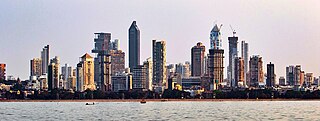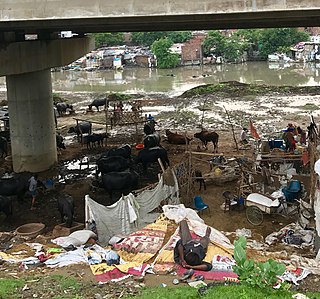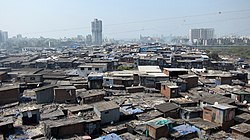
Mumbai, formerly known as Bombay, is the capital city of the Indian state of Maharashtra. Mumbai is the financial capital and the most populous city proper of India with an estimated population of 12.5 million (1.25 crore). Mumbai is the centre of the Mumbai Metropolitan Region, the sixth-most populous metropolitan area in the world with a population of over 23 million. Mumbai lies on the Konkan coast on the west coast of India and has a deep natural harbour. In 2008, Mumbai was named an alpha world city. Mumbai has the highest number of billionaires out of any city in Asia.

A slum is a highly populated urban residential area consisting of densely packed housing units of weak build quality and often associated with poverty. The infrastructure in slums is often deteriorated or incomplete, and they are primarily inhabited by impoverished people. Although slums are usually located in urban areas, in some countries they can be located in suburban areas where housing quality is low and living conditions are poor. While slums differ in size and other characteristics, most lack reliable sanitation services, supply of clean water, reliable electricity, law enforcement, and other basic services. Slum residences vary from shanty houses to professionally built dwellings which, because of poor-quality construction or lack of basic maintenance, have deteriorated.
Matunga is a Suburb in Mumbai, India. It is accessible from the Matunga Road station on the Western line, Matunga station on the Central Line and King's Circle station on the Harbour Line.
Kamathipura is a neighbourhood in Mumbai, India known for prostitution. It was first settled after 1795 with the construction of causeways that connected the erstwhile seven islands of Mumbai. Initially known as Lal Bazaar, it got its name from the Kamathis (workers) of other areas of the country, who were labourers on sexual sites. Due to tough police crackdowns, in the late 1990s with the rise of AIDS and government's redevelopment policy that helped sex workers to move out of the profession and subsequently out of Kamathipura, the number of sex workers in the area has dwindled. In 1992, Brihanmumbai Municipal Corporation (BMC) recorded there were 45,000 sex workers here which was reduced to 1,600 in 2009 and 500 in 2018. Many sex workers have migrated to other areas in Maharashtra with real estate developers taking over the high-priced real estate. In 2018 the Maharashtra government sought tenders to demolish and redevelop the area.

Navi Mumbai also called New Mumbai is a planned city next to Mumbai, located in the Konkan division of the western Indian state of Maharashtra, on the mainland of India. Navi Mumbai is situated across two districts, Thane & Raigad. It is a part of the Mumbai Metropolitan Area.

Wadala is a neighborhood in Mumbai. Wadala Road is a station on the Harbour Line of Mumbai's railway network.

A shanty town, squatter area,squatter settlement, or squatter camp is a settlement of improvised buildings known as shanties or shacks, typically made of materials such as mud and wood, or from cheap building materials such as corrugated tin sheets. A typical shanty town is squatted and in the beginning lacks adequate infrastructure, including proper sanitation, safe water supply, electricity and street drainage. Over time, shanty towns can develop their infrastructure and even change into middle class neighbourhoods. They can be small informal settlements or they can house millions of people.

Orangi is a small town in the western part of Karachi, Pakistan, with a population of 596,919 as of the 2023 census. Orangi was developed as a planned settlement in 1972 by the Karachi Development Authority (KDA) to provide affordable housing for lower-income households. The town consists of 13 union councils.
Jockin Arputham was an Indian community leader and activist, known for his campaigning work of more than 40 years on issues related to slums and shanty towns. He was born in Karnataka, India and moved to Mumbai, where he quickly became politicized and established himself as a community leader. In 2014, he was nominated for the Nobel Peace Prize, alongside the organisation he helped to found, Slum Dwellers International. In 2011, he received the Padma Shri in New Delhi for his contributions to social work, presented by the President of India.

Jawaharlal Nehru National Urban Renewal Mission (JNNURM) was a massive city-modernization scheme launched by the Government of India under the Ministry of Urban Development. It envisaged a total investment of over $20 billion over seven years. It is named after Pandit Jawaharlal Nehru, the first Prime Minister of India. The aim is to encourage reforms and fast track planned development of identified cities. Focus is to be on efficiency in urban infrastructure and service delivery mechanisms, community participation, and accountability of ULBs/ Parastatal agencies towards citizens.
Mahul, Chembur East, Mumbai - 400074 Mahul is a fishing village in Chembur, Mumbai, located on the eastern seafront of the Mumbai Suburban district. Since 2017, Mahul has been in the news for its high levels of pollution and the dismal conditions of its 72-building slum resettlement colony. The area has come to be referred to as Mumbai's "toxic hellhole", "gas chamber", and "human dumping ground", where the poor "are sent to die".
In 2020, 97.7% of Indians had access to the basic water and sanitation facilities. India faces challenges ranging from sourcing water for its megacities to its distribution network which is intermittent in rural areas with continuous distribution networks just beginning to emerge. Non-revenue water is a challenge.
Housing in India varies from palaces of erstwhile maharajas, to modern apartment buildings in big cities, to tiny huts in far-flung villages. The Human Rights Measurement Initiative finds that India is doing 60.9% of what should be possible at its level of income for the right to housing.

Homelessness is a major issue in India. The Universal Declaration of Human Rights defines 'homeless' as those who do not live in a regular residence. The United Nations Economic and Social Council Statement has a broader definition for homelessness; it defines homelessness as follows: ‘When we are talking about housing, we are not just talking about four walls and a roof. The right to adequate housing is about security of tenure, affordability, access to services and cultural adequacy. It is about protection from forced eviction and displacement, fighting homelessness, poverty and exclusion. India defines 'homeless' as those who do not live in Census houses, but rather stay on pavements, roadsides, railway platforms, staircases, temples, streets, in pipes, or other open spaces. There are 1.77 million homeless people in India, or 0.15% of the country's total population, according to the 2011 census consisting of single men, women, mothers, the elderly, and the disabled. However, it is argued that the numbers are far greater than accounted by the point in time method. For example, while the Census of 2011 counted 46,724 homeless individuals in Delhi, the Indo-Global Social Service Society counted them to be 88,410, and another organization called the Delhi Development Authority counted them to be 150,000. Furthermore, there is a high proportion of mentally ill and street children in the homeless population. There are 18 million street children in India, the largest number of any country in the world, with 11 million being urban. Finally, more than three million men and women are homeless in India's capital city of New Delhi; the same population in Canada would make up approximately 30 electoral districts. A family of four members has an average of five homeless generations in India.
Shirish B Patel, is an Indian Civil Engineer and the founder of Shirish Patel & Associates (SPA), a company which designs, manages and inspects structural engineering projects. Patel is a writer and speaker in the media on the topic of urban planning and urban density.

Illegal housing in India consists of huts or shanties built on land not owned by the residents and illegal buildings constructed on land not owned by the builders or developers. Although illegal buildings may afford some basic services, such as electricity, in general, illegal housing does not provide services that afford for healthy, safe environments.

Kaala (also marketed as Kaala Karikalan; transl. Black) is a 2018 Indian Tamil-language action drama film directed and co-written by Pa. Ranjith and produced by Wunderbar Films. The film stars Rajinikanth in the titular role, alongside Nana Patekar, Eswari Rao, Huma Qureshi, Samuthirakani, Pankaj Tripathi, Anjali Patil, K. Manikandan, Dileepan, Nitish Veera, Sampath Raj and Ravi Kale. The film follows Karikalan "Kaala", the leader of Dharavi, who tries save his land and people from getting seized and evicted by Haridev "Hari Dhadha", a ruthless minister.
Ghar Bachao Ghar Banao Aandolan is a people's movement that emerged in the backdrop of massive slum demolitions in Mumbai in 2003–04. It started in 2005 as a struggle for housing rights in Mumbai, and continues to fight for rights of slum-dwellers and those cheated by the builders in various rehabilitation and redevelopment projects, including slum-dwellers, those affected by the Slum Rehabilitation Act and the unorganised sector workers. It is a part of the National Alliance of People's Movements and is led by Medha Patkar.
Slum clearance in India is used as an urban renewal approach to redevelop and transform poor and low income settlements into new developments or housing. Millions of people live in slum dwellings across India and many migrate to live in the slums from rural villages, often in search of work opportunities. Houses are typically built by the slum dwellers themselves and violence has been known to occur when developers attempt to clear the land of slum dwellings.
The Bombay Development Department (BDD) was established in 1920 by the British government with the primary objective of providing more land for housing and constructing 50,000 tenements on reclaimed lands. The Bombay Development Department (BDD) chawls were constructed by the British government between 1920 and 1925. It was established by Sir George Lloyd, the Governor of Bombay.




















